
a web page by Don Roberson |
THRASHERS Mimidae |
||||
|
||||
There is almost nothing so joyful as the song of a California Thrasher (left) in an early spring morning among fragrant California chaparral. This particular bird was in full song at the moment this shot was taken, yet the bill is just half open! Even when the bill is barely open, it can be pouring out were a dizzying array of the calls of flickers, kestrels, wrentits, and many other sounds, but they appeared effortless. What a contrast to, say, a Grasshopper Sparrow which puts its full heart and wide-open beak into his spring song — a tuneless barely audible buzz! Except when perched up and singing, the California Thrasher and many others in this family are very difficult to see as they skulk in the undergrowth. Rarely does one see a California Thrasher in the open (photo below). |
||||
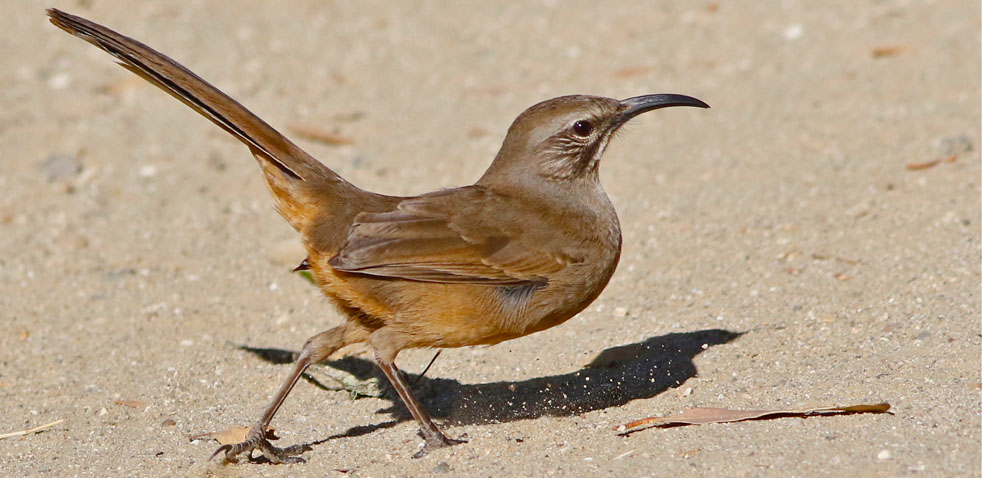 |
||||
In eastern North America, the widespread thrasher is Brown Thrasher (right). Despite its bright rufous colors, it tends to be shy in the undergrowth. Another abundant eastern North American mimid is Gray Catbird (both photos below). On territory it is a skulker, but can sometimes be more easily seen in migration: both of these shots are from Magee Marsh in Ohio in migration. Most often one gets glimpses of the catbird through vegetation (below left); it is not often that a male will be singing out in the open (below right). It, too, has a complex fluty song but it is named for its mewing call note. Gray Catbird and Black Catbird (second row below, left) are the two "catbirds" in the Mimidae. American birders sometimes think those are the only "catbirds" on earth, but there are 11 other birds around the world called "catbirds." After recent splits, there are 10 species of Ailuroedus catbirds in the Bowerbird family [Ptilonorhynchidae]; at least the most common species were named for their mewing, cat-like calls. All are secretive birds more likely heard than seen. In Ethiopia, a skulking babbler-like bird of montane juniper woodlands is called the Abyssinian Catbird Parophasma galinieri. and recently re-assigned from babblers to family Sylviidae on molecular grounds. Males sing a warbling fluty song, to which females respond with "a long dry throaty rattle" (Redman et al. 2009) that some sources call a "purr." Except for that possibility, I have no idea why it is called a "catbird." The northern mimids — such as Brown Thrasher and Gray Catbird — are migrants that move south in winter. Migration leads to navigation errors and vagrants. Thus these eastern North American species, including Gray Catbird and Brown Thrasher, occasionally turn up in California where I live, but we average at best maybe one a year. This Brown Thrasher (right or just above) was a vagrant that wintered in Pacific Grove. |
||||
|
||||
The 34 species of mimids are distributed among ten genera. Gray Catbird is in its own genera (Dumetella), and Black Catbird (above left) is in another monotypic genus (Melanoptila). Gray Catbird is an abundant widespread species but Black Catbird has but a small population restricted to Cozumel Island (where it is easier to see) and the adjacent Yucatan Peninsula, Mexico (where it is rare). The most speciose genera are thrashers (10 species in Toxostoma) and mockingbirds (14 species in genus Mimus). Turning first to thrashers, these are mostly United States and Mexico birds. When I first started birding enthusiastically as a college freshman, I really craved a trip to souther Arizona to search for the fine thrashers shown in my Golden Guide field guide: Curve-billed T. curvirostre, Bendire's T. bendirei, LeConte's T. lecontei, and Crissal T. crissale. Some of those were limited to specific habitats, including the lovely pale-gray LeConte's Thrasher (above right) which occurs in exceedingly dry, arid country in southern California and the U.S. southwest. Curve-billed Thrasher (left) ranges from Arizona to Texas to n. Mexico. Both of the two field-identifiable groups have reached California as vagrants (left is a vagrant of the eastern group in northern California) Specialized species include Ocellated Thrasher T. ocellatum (restricted to oak-pine highlands of Oaxaca, Mexico), Cozumel Thrasher T. guttatum (endemic to Cozumel I. off the Yucatan Peninsula, Mexico), and the endangered White-breasted Thrasher Ramphocinclus brachyurus (found only on the Lesser Antillean islands of St. Lucia and Martinique). Almost all the mimids (except most Mockingbirds, which we'll discuss next) prefer dense thickets and undergrowth, making them difficult to locate. The same can also be said for mockingbirds in the genus Melanotis: Blue Mockingbird Melanotis caerulescens and Blue-and-white Mockingbird M. hypoleucus. Both are skulking mockingbirds of Mexico; Blue has reached the southwest U.S. as a vagrant. A final American thrasher is a sagebrush denizen: Sage Thrasher (below) which is in its own genus (Oreoscoptes). It is a short-billed thrasher, lacking the long curved bills shown by all the other western U.S. species. As other thrashers, its spring song brings life to the wide-open stretches of the Great Basin sagebrush. Populations in sagebrush with cold winters move south in winter, and some of them even reach the California coast. This one (below) wintered on the Monterey Peninsula, spending the day in a fruiting Pyrracantha bush and occasionally posing for a few moments on this wall. |
||||
 |
||||
|
||||
While thrashers and catbirds have wonderful vocalizations, perhaps the best known of all mimickers are the mockingbirds in genus Mimus. The most well-known is Northern Mockingbird M. polyglottos which is widespread in the southern United States (two photos above). Its Latin name translates to "many-throated mimic" and its song is a constant sound in lightly-wooded open country in the spring. Its habitat includes suburbs to magnolia gardens to southwestern deserts. The species used to be restricted to southern California but with the opening of California to human development in the 19th and 20th centuries, Northern Mockingbirds spread north throughout the Central Valley and into the Bay Area by the mid-1900s (Arnold 1980). They have now reached the far northwest in the state.
Love 'em or hate 'em, Northern Mockingbirds are the official State birds of Arkansas, Florida, Mississippi, Tennessee, and Texas. The bird is such a fine mimic that one can often determine what other species are around by identifying each rendition. I recall a time some years back when I first recognized a crossbill invasion was starting because the local mockingbird starting incorporated the "kip" notes of Red Crossbills! While the thrashers, catbird, and Melanotis mockingbirds are restricted to North & Central America, plus the Caribbean, the Mimus mockingbirds also range throughout South America. Chalk-browed Mockingbird (right) is a bird of open country in eastern South America, at least where there are a few trees. It now inhabits urban parks and gardens, and is among the species whose range has expanded with the cutting of the rainforest. The Bahama Mockingbird (below left) is restricted to arid scrub in the Bahamas and there is a small coastal-zone population in Cuba; it has reached Florida as a vagrant. Four species of mockingbirds are restricted to the Galapagos Islands. Formerly assigned to genus "Nesomimus," these are now merged into genus Mimus. This is the more widespread Galapagos Mockingbird (below right), but the three others are endemic to one or two tiny islets each. These Galapagos birds are extremely unwary and bold, eagerly checking out humans for potential tidbits and sometimes landing on camera lens or boots! Given this behavior, several species have suffered from the introduction of non-native predators (rats, cats) and special efforts are underway to save some species from extinction. |
||||
|
||||
Two more thrashers, in two genera, inhabit the eastern Caribbean. Scaly-breasted Thrasher Allenia fusca is restricted to the Lesser Antilles. Pearly-eyed Thrasher (right) is more widespread, although patchily, from the southern Bahamas and Hispaniola through the Lesser Antilles. Pearly-eyed Thrasher seems to fill the "jay" niche in the Caribbean, being omnivorous (look at that bill!) and searching out other bird's nests for eggs or fledglings. It is often arboreal, and banding studies show it to be more common in rainforests than in other habitats (Cody 2005). |
||||
Brown Trembler prefers wet rain forest; Gray Trembler C. gutturalis of St. Lucia and Martinique also extends into dryer woods. Both have the very odd habit of quivering their wings while at a perch ["trembling," as it were] but otherwise remaining remarkably unobtrusive. Their arboreal, probing activities reminded me of some long-billed foliage-gleaners in South America, but the trembling behavior was altogether unique. |
||||
Photos: The photos of California Thrasher Toxostoma redivivum were from Carmel R. mouth, Monterey Co., California (singing) on 17 Oct 2015, and from San Lorenz county park, King City, California (running), on 12 Oct 2018. The Brown Thrasher Toxostoma rufum was wintering in Pacific Grove, Monterey Co., California, on 28 Dec 2013. The two photos of Gray Catbird Dumetella carolinensis were both from Magee Marsh Reserve, Ohio, on 21 May 2019 (skulking) and 2 June 2017 (singing). The Black Catbird Melanoptila glabrirostris was on Cozumel I., Mexico, on 2 Sep 1979. The LeConte's Thrasher Toxostoma lecontei was in the Carrizzo Plains NM, California, on 28 Mar 2010. The Curve-billed Thrasher Toxostoma curvirostre, of the eastern subspecies, group, was at vagrant at Woodland, California, on 21 Jan 2018. The vagrant Sage Thrasher Oreoscoptes montanus was at Laguna Grande Park, Seaside, Monterey Co., California, on 10 Dec 2018. The performing Northern Mockingbird Mimus polyglottus was adjacent to Ft. Ord NM, Monterey Co., California, on 20 June 2020. The Chalk-browed Mockingbird Mimus saturninus was in Emas NP, Brazil, on 28 July 2010. The Bahama Mockingbird Mimus gundlachii was on San Salvador I., Bahamas, on 18 May 1983. The Galapagos Mockingbird Mimus parvulus was on Santa Cruz I., Galapagos, on 25 Sep 1989. The Pearly-eyed Thrasher Margarops fuscatus was on the prowl at Cinnamon Bay, St. John I., Virgin Islands NP, on 28 Aug 1979. The Brown Trembler Cinclocerthia ruficauda was at the entrance to the "Emerald Pool" in the central highlands of Dominica on 24 Mar 2000. All photos © Don Roberson; all rights reserved. Bibliographic note: There apparently is a family book, by Dave Brewer & Sean McMinn, with illustrations by Barry Kent MacKay, in the Yale Univ. Press series — A Guide to the Wrens, Dippers, and Thrashers of the World (2001) — but I have not seen it. The reviews were luke-warm. A fine introduction to this family, with some good photos, is in Cody (2005). Before that was published, I gleaned information for my first-edition page from Bent (1948) and my own experiences (some mentioned in Roberson & Tenney 1993). An outstanding set of tapes — back when birders used cassette tapes -- was Hardy et al. (1987). Literature cited:
|
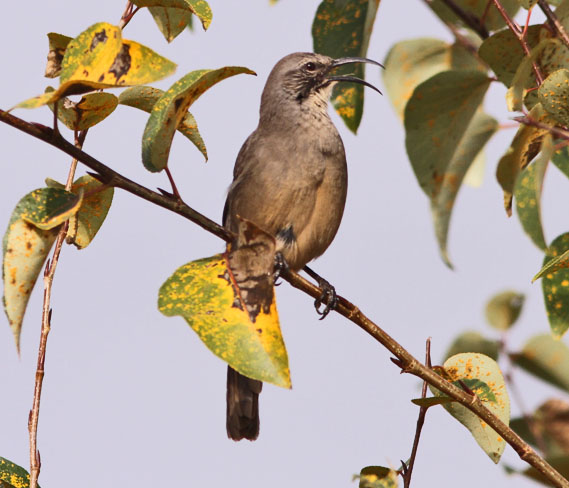 The Mimidae is a New World family comprised of thrashers, mockingbirds, and New World catbirds. These are particularly known for their vocalizations, many of which include fantastic mimicry of other birds and outdoor sounds (thus "mimids" for mimickers).
The Mimidae is a New World family comprised of thrashers, mockingbirds, and New World catbirds. These are particularly known for their vocalizations, many of which include fantastic mimicry of other birds and outdoor sounds (thus "mimids" for mimickers). 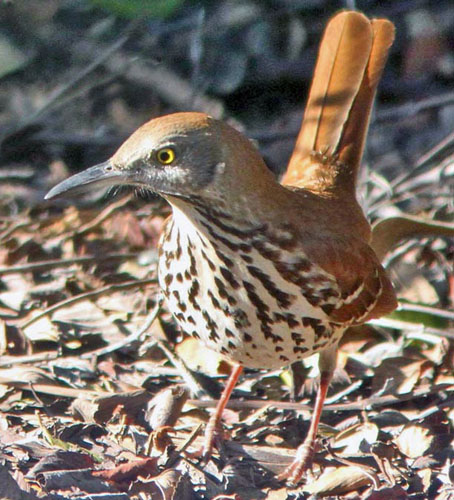
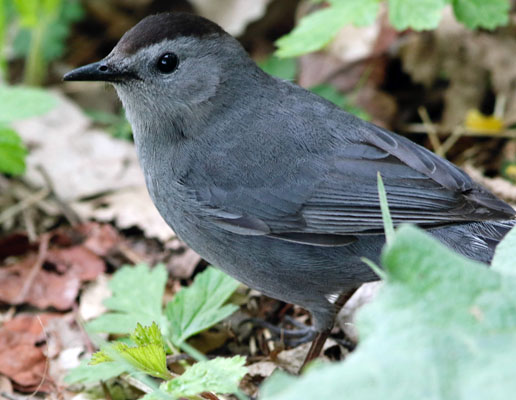
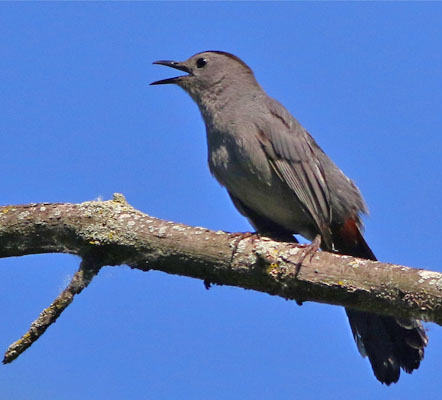
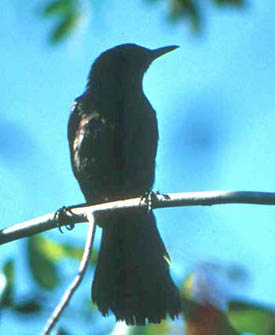
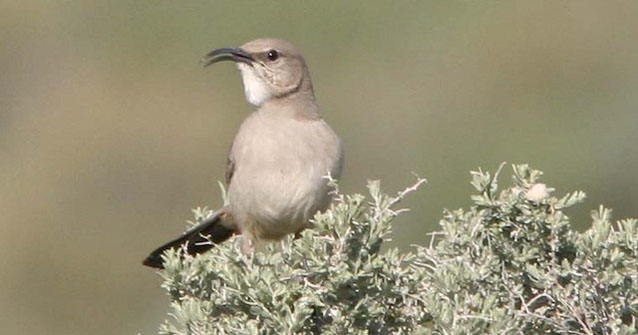
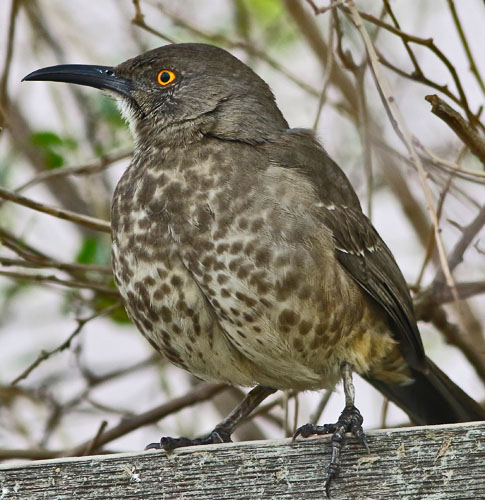 The taxonomic relationships of the Mimidae are comparatively settled. They are genetically related to starlings, and Sibley & Ahlquist (1990) emphasized this by placing them simply as a "tribe" among the starling family (Sturnidae). The Mimidae is part of the muscicapoid radiation of oscine passerines, and Mimidae is sister to starlings (Sturnidae; Barker et al. 2004).
The taxonomic relationships of the Mimidae are comparatively settled. They are genetically related to starlings, and Sibley & Ahlquist (1990) emphasized this by placing them simply as a "tribe" among the starling family (Sturnidae). The Mimidae is part of the muscicapoid radiation of oscine passerines, and Mimidae is sister to starlings (Sturnidae; Barker et al. 2004). 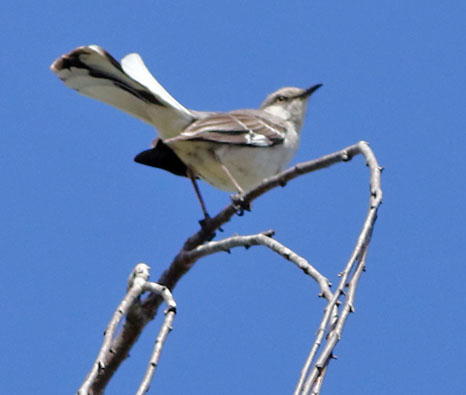
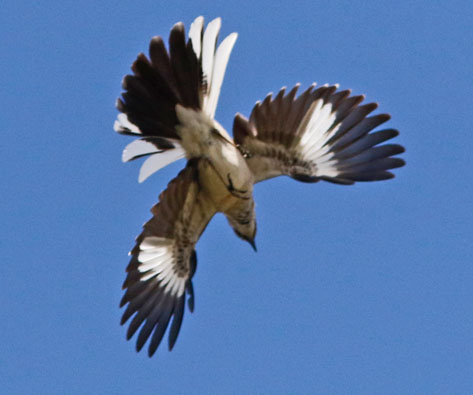
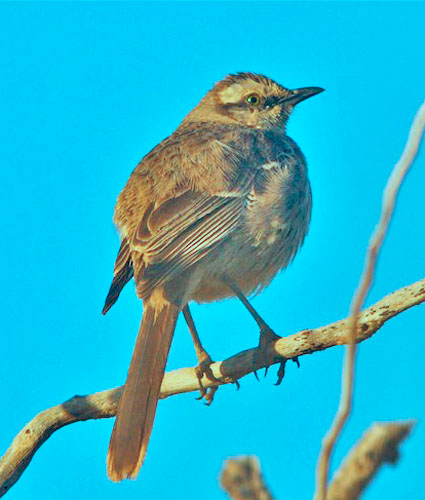 Many mockingbirds sing all day long in season, sometimes pouring out pure music flight while displaying white patches in wings and tail in flight (above right). Some mockingbirds also sing all night – provoking numerous complaints from insomniacs — and aggressively defend their nest-sites from hawks, jays, cats, dogs and unwary people! Bent (1948) quotes T. Gilbert Pearson who wrote that the mockingbird
Many mockingbirds sing all day long in season, sometimes pouring out pure music flight while displaying white patches in wings and tail in flight (above right). Some mockingbirds also sing all night – provoking numerous complaints from insomniacs — and aggressively defend their nest-sites from hawks, jays, cats, dogs and unwary people! Bent (1948) quotes T. Gilbert Pearson who wrote that the mockingbird 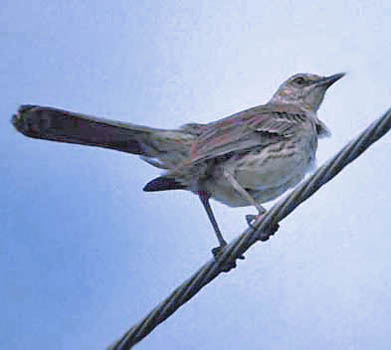
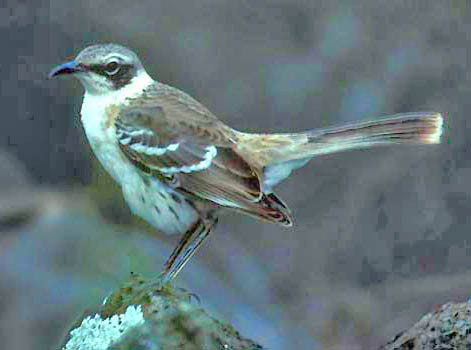
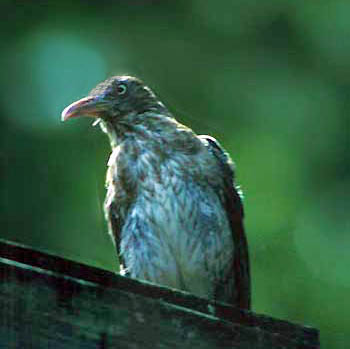
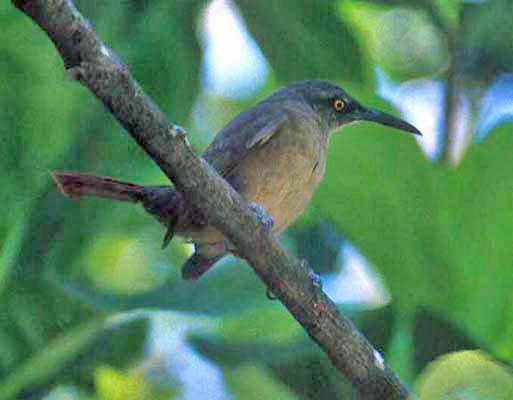 It was in the Caribbean islands of St. Lucia, St. Vincent, and Dominica that I encountered perhaps the strangest thrashers of all — the two species of tremblers (genus Cinclocerthia). This is Brown Trembler (left), striking a characteristic stance with cocked tail. I had expected to find them in the undergrowth, like other thrashers, but these are arboreal specialists. They use their long thin bills to probe bromeliads and leaf-clusters in the canopy. I thought there was no way I'd get a photo of these canopy dwellers, but a pair was nest-building in the eaves at the entrance cafe at the "Emerald Pool" on Dominica. The birds used the same perch to fly to and from the hidden nest site. So I upturned a restaurant chair as a tripod and took a few shots on slide film. The birds were oblivious to hordes of tourists, brought by vans from their cruise ships, pouring into the entrance booth or eating at the cafe just below their nest.
It was in the Caribbean islands of St. Lucia, St. Vincent, and Dominica that I encountered perhaps the strangest thrashers of all — the two species of tremblers (genus Cinclocerthia). This is Brown Trembler (left), striking a characteristic stance with cocked tail. I had expected to find them in the undergrowth, like other thrashers, but these are arboreal specialists. They use their long thin bills to probe bromeliads and leaf-clusters in the canopy. I thought there was no way I'd get a photo of these canopy dwellers, but a pair was nest-building in the eaves at the entrance cafe at the "Emerald Pool" on Dominica. The birds used the same perch to fly to and from the hidden nest site. So I upturned a restaurant chair as a tripod and took a few shots on slide film. The birds were oblivious to hordes of tourists, brought by vans from their cruise ships, pouring into the entrance booth or eating at the cafe just below their nest.